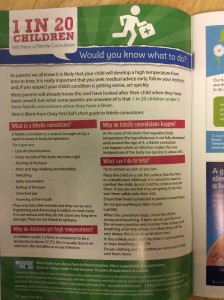1 in 20 Children Will Have a Febrile Convulsion
Would you know what to do?
By Marie Gale, Daisy First Aid, Northampton
As parents we all know it is likely that your child will develop a high temperature from time to time. It is really important that you seek medical advice early, follow your instincts and, if you suspect your child’s condition is getting worse, act quickly. Most parents will already know this and have looked after their child when they have been unwell, but what some parents are unaware of is that 1 in 20 children under 5 have febrile convulsions when they have a fever.
Here is Marie from Daisy First Aid’s short guide to febrile convulsions:
What is a febrile convulsion?
A febrile convulsion is a seizure, brought on by a rapid increase in body temperature.
The signs are:
- Loss of consciousness
- Every muscle of the body becomes rigid
- Arching of the back
- Arms and legs shaking uncontrollably
- Twitching
- Jerky movements
- Rolling of the eyes
- Clenched jaw
- Foaming of the mouth
They only last a few minutes but they can be very frightening and distressing to watch. In most cases it is not serious and they do not cause any long term damage. They are not linked to epilepsy.
Why do children get high temperatures?
In children under 5 a fever is considered to be a temperature above 37.5⁰c, this is usually due to an infection, like tonsillitis or an ear infection.
Why do febrile convulsions happen?
A febrile convulsion can happen when an infection makes the core temperature of the body rise quickly to above 38⁰c. As the area of the brain that regulates body temperature (the hypothalamus) is not fully developed until around the age of 4.
What can I do to help?
Try to remain as calm as you can.
Place the child on a safe flat surface, like the floor or a double bed. Although it is natural to want to comfort the child, do not hold the child or restrain them. If you are worried they are going to be sick, turn them safely onto their side.
Ensure their head is protected to prevent a head injury.
Do not put anything in their mouth.
Call 999.
When the convulsion stops, check the child’s airway and breathing. If both are ok, put them in the recovery position and monitor their airway and breathing until help arrives. It is likely they will be very sleepy, this is usual, so let them rest.
In the unlikely event that the child is not breathing or stops breathing start CPR.
Ensure clothing and bedclothes are removed to help cool them down.
Marie Gale runs Daisy First Aid Northampton. She is a paediatric first aid trainer, mum to 2 boys under 5 and has over 10 years of experience as a nurse.
Daisy First Aid provides 2 hour First Aid classes for parents and carers in the comfort of your own home or at local venues. Classes are fun and informal but leave you with the confidence and skills to know what to do if an emergency, accident or illness occurred.
For more information contact: marie@daisyfirstaid.com www.daisyfirstaid.com

